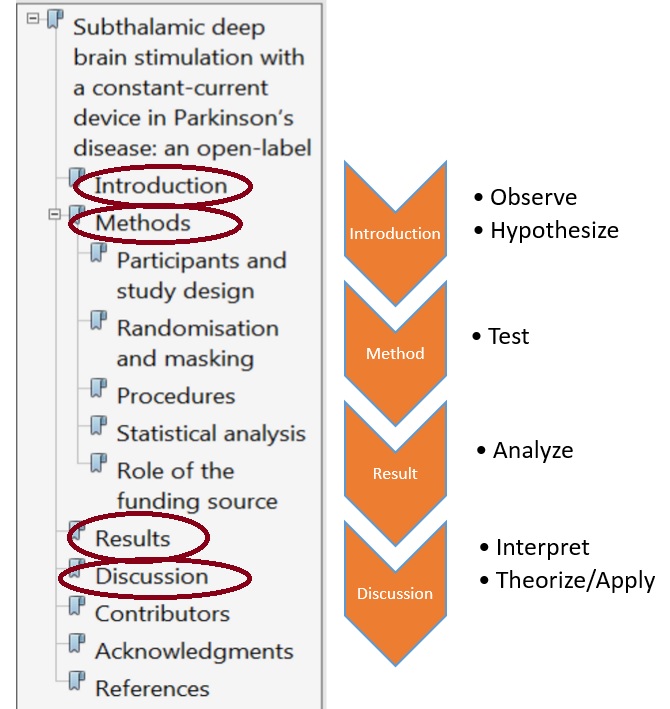Review articles, including meta-analyses, are critical evaluations of material that has already been published. By organizing, integrating, and evaluating previously published material, the author of a review article considers the progress of current research toward clarifying a problem. from APA Manual, 2001, 7
 To understand Reviews as a kind of scientific publication, it helps to compare them to Research Reports, the type of publication with which we are most familiar. A research report explains the investigation and results of a single research question (or small set of highly-related questions) as a logically ordered sequence of events (an idealized version of the scientific method). Research Reports are published in a format we are very familiar with, the IMRD, that nicely projects an idealized version of the scientific method. Thus, an outline to the parts of a research report shows some version of the functional subheadings — Introduction, Method, Results, Discussion — to move the reader through the text.
To understand Reviews as a kind of scientific publication, it helps to compare them to Research Reports, the type of publication with which we are most familiar. A research report explains the investigation and results of a single research question (or small set of highly-related questions) as a logically ordered sequence of events (an idealized version of the scientific method). Research Reports are published in a format we are very familiar with, the IMRD, that nicely projects an idealized version of the scientific method. Thus, an outline to the parts of a research report shows some version of the functional subheadings — Introduction, Method, Results, Discussion — to move the reader through the text.

A review paper is a different beast altogether. Where research reports include the expert literature primarily in the Introduction and Discussion sections, a Review paper examines only published reports to explain what is happening in an area of research as a whole — no experimentation is done. The organization is topical, not functional (though “Introduction” and “Conclusions” are still present). The main sections of the paper have informative titles — mini-titles for the information in that section. Review Articles make a different sort of contribution to science (McMillan, 2001, 3, emphasis added):
In contrast to research papers, conference presentations, and proposals, a review paper is a journal article that synthesizes work by many independent researchers on a particular subject or scientific problem. By bringing together the most pertinent findings of a large number of studies, a review paper serves as a valuable summary of research. Although it does not present the writer’s new discoveries, it does reflect his or her painstaking review of the literature in a defined field. Moreover, a good review not only summarizes information but also provides interpretative analysis and sometimes a historical perspective. Reviews may vary in aims, scope, length, and format, but they all include a relatively lengthy reference section. Journal editors sometimes invite prominent experts to write reviews of their particular fields, since the ability to give an audience an authoritative overview of a subject usually develops with experience. Whether solicited or unsolicited, review papers still must conform to journal specifications, and their author receive feedback from editors and reviewers before final publication. (MacMillan, How and Why Biologists Write, 2001, 3)

Thus, the published review article has very different features from a research report. Professionally produced review articles have huge bibliographies, often 60-120 or more sources long. The task of the writer isn’t to answer a specific question using some kind of experimental method, but to take a step back and look at what is going on across many individual research projects. It’s one of those “forest and tree” situations: in a research report, the scientists are reporting on a tree; in a review paper, the scientist is looking at the forest. In science, the review writer tries to understand what is happening across an area research, to discover patterns among the individual pieces of research that experimental researchers may not be aware of. Reviewers provide two very important and practical contributions to science. First, they do the hard work of all the reading required so that research results are regularly gathered in one place. Second, reviewers evaluate current research trends and make recommendations for where research and/or applications of research should be focused.
There are many different types of reviews, for example, reviews of methods or historical reviews. You will probably be writing the most common and useful review (for a health practitioner): the State of the Art Review — “A state-of-the-art review presents an up-to-date, interpretative synthesis of our knowledge of a certain subject or issue, with emphasis on the most recent literature. For example, an author might look at what is currently known about the advantages and disadvantages of a particular surgical method for mastectomy, or a particular chemotherapy regime in the treatment of breast cancer.” –“How and Why Biologists Write”, Writing Papers in the Biological Sciences, McMillan, 2006, 114.
Content
- Craft a Point of View (POV)
- Map the Content
- Draft the Paper
- Action Plan and Outlines